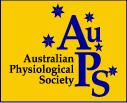



|

|

|
| Sunday 2nd December 2012 | |||||||
| Mathews A | Mathews B | Mathews C | Mathews D | ||||
| 17:30 |
Opening Ceremony
Location: Mathews A |
||||||
|
AuPS Invited Lecture - Prof Joe Lynch
Location: Mathews A
|
|||||||
| 18:00 | |||||||
| 18:30 | |||||||
|
Welcome reception
Location: Pavillion |
|||||||
| 19:00 | |||||||
| 19:30 | |||||||
| 20:00 | |||||||
| 20:30 | |||||||
| 21:00 | |||||||
| 21:30 | |||||||
| Monday 3rd December 2012 | ||||||||||||||||||||||||||||||||||||||||||||||||||||||||||||||||||||||||||||||||||||||||||||||||||||||||||||||||||||||||||||||||||||||||||||||||||||||||||||||||
| Mathews A | Mathews B | Mathews C | Mathews D | |||||||||||||||||||||||||||||||||||||||||||||||||||||||||||||||||||||||||||||||||||||||||||||||||||||||||||||||||||||||||||||||||||||||||||||||||||||||||||||
| 08:30 |
Symposium: New insights into cardiac Ca2+ handling and excitability Chairs: Yue-kun Ju & David Allen
|
Symposium: Assessment in physiology - Changing philosophy and practice Chairs: Lesley Ulman & Phil Poronnik
|
Symposium: Advances in methods for intestinal motility Chair: Marcello Costa
|
Free Communications - Exercise Physiology
Location: Mathews D Chairs: Glenn Wadley & Simon Green
|
||||||||||||||||||||||||||||||||||||||||||||||||||||||||||||||||||||||||||||||||||||||||||||||||||||||||||||||||||||||||||||||||||||||||||||||||||||||||||||
| 09:00 | ||||||||||||||||||||||||||||||||||||||||||||||||||||||||||||||||||||||||||||||||||||||||||||||||||||||||||||||||||||||||||||||||||||||||||||||||||||||||||||||||
| 09:30 | ||||||||||||||||||||||||||||||||||||||||||||||||||||||||||||||||||||||||||||||||||||||||||||||||||||||||||||||||||||||||||||||||||||||||||||||||||||||||||||||||
| 10:00 | ||||||||||||||||||||||||||||||||||||||||||||||||||||||||||||||||||||||||||||||||||||||||||||||||||||||||||||||||||||||||||||||||||||||||||||||||||||||||||||||||
| 10:30 | Morning tea | |||||||||||||||||||||||||||||||||||||||||||||||||||||||||||||||||||||||||||||||||||||||||||||||||||||||||||||||||||||||||||||||||||||||||||||||||||||||||||||||
| 11:00 |
Symposium: Molecular insight via advanced fluorescence microscopy Chair: Till Böcking
|
Symposium: Cystic fibrosis: Today and tomorrow Chair: Kirk Hamilton
|
Symposium: Bridging the gap between molecular reductionism and physiology- the usefulness of ‘omics’ Chair: Matthew Watt
|
Free Communications - General Physiology
Chair: Andrew Moorhouse
|
||||||||||||||||||||||||||||||||||||||||||||||||||||||||||||||||||||||||||||||||||||||||||||||||||||||||||||||||||||||||||||||||||||||||||||||||||||||||||||
| 11:30 | ||||||||||||||||||||||||||||||||||||||||||||||||||||||||||||||||||||||||||||||||||||||||||||||||||||||||||||||||||||||||||||||||||||||||||||||||||||||||||||||||
| 12:00 | ||||||||||||||||||||||||||||||||||||||||||||||||||||||||||||||||||||||||||||||||||||||||||||||||||||||||||||||||||||||||||||||||||||||||||||||||||||||||||||||||
| 12:30 | ||||||||||||||||||||||||||||||||||||||||||||||||||||||||||||||||||||||||||||||||||||||||||||||||||||||||||||||||||||||||||||||||||||||||||||||||||||||||||||||||
| 13:00 |
Posters and Lunch
Location: Pavillion Presenting authors of posters on odd numbered boards in attendance.
|
|||||||||||||||||||||||||||||||||||||||||||||||||||||||||||||||||||||||||||||||||||||||||||||||||||||||||||||||||||||||||||||||||||||||||||||||||||||||||||||||
| 13:30 | ||||||||||||||||||||||||||||||||||||||||||||||||||||||||||||||||||||||||||||||||||||||||||||||||||||||||||||||||||||||||||||||||||||||||||||||||||||||||||||||||
| 14:00 | ||||||||||||||||||||||||||||||||||||||||||||||||||||||||||||||||||||||||||||||||||||||||||||||||||||||||||||||||||||||||||||||||||||||||||||||||||||||||||||||||
| 14:30 |
Symposium: Spectral imaging in physiology – a highlight of techniques Chair: Robyn Murphy
|
Free communications - Channels: Molecular Interactions
Chair: Boris Martinac
|
Free communications - Cardiac Physiology
Chair: Lea Delbridge
|
Free Communcations - Neuro-signalling
Location: Mathews D Chair: John Power
|
||||||||||||||||||||||||||||||||||||||||||||||||||||||||||||||||||||||||||||||||||||||||||||||||||||||||||||||||||||||||||||||||||||||||||||||||||||||||||||
| 15:00 | ||||||||||||||||||||||||||||||||||||||||||||||||||||||||||||||||||||||||||||||||||||||||||||||||||||||||||||||||||||||||||||||||||||||||||||||||||||||||||||||||
| 15:30 | ||||||||||||||||||||||||||||||||||||||||||||||||||||||||||||||||||||||||||||||||||||||||||||||||||||||||||||||||||||||||||||||||||||||||||||||||||||||||||||||||
| 16:00 | Afternoon tea | |||||||||||||||||||||||||||||||||||||||||||||||||||||||||||||||||||||||||||||||||||||||||||||||||||||||||||||||||||||||||||||||||||||||||||||||||||||||||||||||
| 16:30 |
Symposium: Perinatal asphyxia: adaptation and consequences Chair: Alistair Jan Gunn
|
Symposium: A vignette of TRP ion channel physiology Chair: Gary Housley
|
Free Communications: ASB Young Investigator & Spectroscopy
Location: Mathews C Chairs: Jamie Vandenberg & Frances Separovic
|
Free Communications - Muscle Metabolism/Signalling
Chair: Matthew Watt
|
||||||||||||||||||||||||||||||||||||||||||||||||||||||||||||||||||||||||||||||||||||||||||||||||||||||||||||||||||||||||||||||||||||||||||||||||||||||||||||
| 17:00 | ||||||||||||||||||||||||||||||||||||||||||||||||||||||||||||||||||||||||||||||||||||||||||||||||||||||||||||||||||||||||||||||||||||||||||||||||||||||||||||||||
| 17:30 | ||||||||||||||||||||||||||||||||||||||||||||||||||||||||||||||||||||||||||||||||||||||||||||||||||||||||||||||||||||||||||||||||||||||||||||||||||||||||||||||||
| 18:00 | ||||||||||||||||||||||||||||||||||||||||||||||||||||||||||||||||||||||||||||||||||||||||||||||||||||||||||||||||||||||||||||||||||||||||||||||||||||||||||||||||
| 18:30 | ||||||||||||||||||||||||||||||||||||||||||||||||||||||||||||||||||||||||||||||||||||||||||||||||||||||||||||||||||||||||||||||||||||||||||||||||||||||||||||||||
| 19:00 | ||||||||||||||||||||||||||||||||||||||||||||||||||||||||||||||||||||||||||||||||||||||||||||||||||||||||||||||||||||||||||||||||||||||||||||||||||||||||||||||||
| 19:30 | Student Member Function - BBQ in the Whitehouse | |||||||||||||||||||||||||||||||||||||||||||||||||||||||||||||||||||||||||||||||||||||||||||||||||||||||||||||||||||||||||||||||||||||||||||||||||||||||||||||||
| 20:00 | ||||||||||||||||||||||||||||||||||||||||||||||||||||||||||||||||||||||||||||||||||||||||||||||||||||||||||||||||||||||||||||||||||||||||||||||||||||||||||||||||
| 20:30 | ||||||||||||||||||||||||||||||||||||||||||||||||||||||||||||||||||||||||||||||||||||||||||||||||||||||||||||||||||||||||||||||||||||||||||||||||||||||||||||||||
| 21:00 | ||||||||||||||||||||||||||||||||||||||||||||||||||||||||||||||||||||||||||||||||||||||||||||||||||||||||||||||||||||||||||||||||||||||||||||||||||||||||||||||||
| 21:30 | ||||||||||||||||||||||||||||||||||||||||||||||||||||||||||||||||||||||||||||||||||||||||||||||||||||||||||||||||||||||||||||||||||||||||||||||||||||||||||||||||
| 22:00 | ||||||||||||||||||||||||||||||||||||||||||||||||||||||||||||||||||||||||||||||||||||||||||||||||||||||||||||||||||||||||||||||||||||||||||||||||||||||||||||||||
| Tuesday 4th December 2012 | |||||||||||||||||||||||||||||||||||||||||||||||||||||||
| Mathews A | Mathews B | Mathews C | Mathews D | ||||||||||||||||||||||||||||||||||||||||||||||||||||
| 08:30 |
AuPS Plenary Lecture - Scandinavian Exchange Lecturer - Prof Håkan Westerblad
|
||||||||||||||||||||||||||||||||||||||||||||||||||||||
| 09:00 | |||||||||||||||||||||||||||||||||||||||||||||||||||||||
| 09:30 | Morning tea | ||||||||||||||||||||||||||||||||||||||||||||||||||||||
| 10:00 |
Symposium: Calcium signalling in microdomains essential to normal cell function Chair: Bradley Launikonis
|
Symposium: Science at the high performance computing frontier Chair: Adam Hill
|
Free communications - Transporters
Chair: Tim Murphy
|
||||||||||||||||||||||||||||||||||||||||||||||||||||
| 10:30 | |||||||||||||||||||||||||||||||||||||||||||||||||||||||
| 11:00 | |||||||||||||||||||||||||||||||||||||||||||||||||||||||
| 11:30 | |||||||||||||||||||||||||||||||||||||||||||||||||||||||
| 12:00 |
Posters and Lunch - ASB AGM (Mathews 312) - PSNZ AGM (Mathews 125)
Presenting authors of posters on even numbered boards in attendance. |
||||||||||||||||||||||||||||||||||||||||||||||||||||||
| 12:30 | |||||||||||||||||||||||||||||||||||||||||||||||||||||||
| 13:00 | |||||||||||||||||||||||||||||||||||||||||||||||||||||||
| 13:30 |
Symposium: Muscular adaptations to exercise: mechanisms at play Chair: David Simar
|
Symposium: Integrative physiology of the heart Chairs: Bruce Smaill & Jamie Vandenberg
|
Free communications - Molecular Dynamics
Chair: Toby Allen
|
||||||||||||||||||||||||||||||||||||||||||||||||||||
| 14:00 | |||||||||||||||||||||||||||||||||||||||||||||||||||||||
| 14:30 | |||||||||||||||||||||||||||||||||||||||||||||||||||||||
| 15:00 | |||||||||||||||||||||||||||||||||||||||||||||||||||||||
| 15:30 | Afternoon tea | ||||||||||||||||||||||||||||||||||||||||||||||||||||||
| 16:00 |
Free communications - Gene for Speed
Chair: Peter Houweling
|
Free Communications - Cardiac Physiology
Chair: Nicole Beard
|
PSNZ - John Hubbard and Mary Bullivant Student Prize Competition
|
||||||||||||||||||||||||||||||||||||||||||||||||||||
| 16:30 | |||||||||||||||||||||||||||||||||||||||||||||||||||||||
| 17:00 | |||||||||||||||||||||||||||||||||||||||||||||||||||||||
| 17:30 | |||||||||||||||||||||||||||||||||||||||||||||||||||||||
| 18:00 | Conference Dinner and Awards | ||||||||||||||||||||||||||||||||||||||||||||||||||||||
| 18:30 | |||||||||||||||||||||||||||||||||||||||||||||||||||||||
| 19:00 | |||||||||||||||||||||||||||||||||||||||||||||||||||||||
| 19:30 | |||||||||||||||||||||||||||||||||||||||||||||||||||||||
| 20:00 | |||||||||||||||||||||||||||||||||||||||||||||||||||||||
| 20:30 | |||||||||||||||||||||||||||||||||||||||||||||||||||||||
| 21:00 | |||||||||||||||||||||||||||||||||||||||||||||||||||||||
| 21:30 | |||||||||||||||||||||||||||||||||||||||||||||||||||||||
| 22:00 | |||||||||||||||||||||||||||||||||||||||||||||||||||||||
| 22:30 | |||||||||||||||||||||||||||||||||||||||||||||||||||||||
| Wednesday 5th December 2012 | ||||||||||||||||||||||||||||||||||||||||||||||||||||||||||||||||
| Mathews A | Mathews B | Mathews C | Mathews D | |||||||||||||||||||||||||||||||||||||||||||||||||||||||||||||
| 09:00 |
Invited Lecture - Prof Lutz Birnbaumer
|
|||||||||||||||||||||||||||||||||||||||||||||||||||||||||||||||
| 09:30 | ||||||||||||||||||||||||||||||||||||||||||||||||||||||||||||||||
| 10:00 | Morning tea | |||||||||||||||||||||||||||||||||||||||||||||||||||||||||||||||
| 10:30 |
Symposium: Brain dysfunction and translational neurophysiology Chairs: Andrew Moorhouse & Arun Krishnan
|
Symposium: Autonomic physiology - nutrient sensing in the GI tract Chair: Paul Bertrand
|
Symposium: Skeletal muscle in health and disease Chair: Gordon Lynch
|
|||||||||||||||||||||||||||||||||||||||||||||||||||||||||||||
| 11:00 | ||||||||||||||||||||||||||||||||||||||||||||||||||||||||||||||||
| 11:30 | ||||||||||||||||||||||||||||||||||||||||||||||||||||||||||||||||
| 12:00 | ||||||||||||||||||||||||||||||||||||||||||||||||||||||||||||||||
| 12:30 | Lunch - AuPS AGM | |||||||||||||||||||||||||||||||||||||||||||||||||||||||||||||||
| 13:00 | ||||||||||||||||||||||||||||||||||||||||||||||||||||||||||||||||
| 13:30 | ||||||||||||||||||||||||||||||||||||||||||||||||||||||||||||||||
| 14:00 |
Symposium: Developments in auditory and vestibular physiology Chair: Ramesh Rajan
|
Symposium: Ion Channels as drug targets Chairs: Trevor Lewis & Joe Lynch
|
Free Communications - Muscle Diseases
Chair: Stewart Head
|
|||||||||||||||||||||||||||||||||||||||||||||||||||||||||||||
| 14:30 | ||||||||||||||||||||||||||||||||||||||||||||||||||||||||||||||||
| 15:00 | ||||||||||||||||||||||||||||||||||||||||||||||||||||||||||||||||
| 15:30 | ||||||||||||||||||||||||||||||||||||||||||||||||||||||||||||||||
| 16:00 | ||||||||||||||||||||||||||||||||||||||||||||||||||||||||||||||||
| 16:30 | Afternoon tea and Drinks - Closing Reception and Awards | |||||||||||||||||||||||||||||||||||||||||||||||||||||||||||||||
| 17:00 | ||||||||||||||||||||||||||||||||||||||||||||||||||||||||||||||||
Administration access - requires authorisation
|
Copyright © 1996-2024 AuPS Inc. Last updated 11 December 2018.
Comments or questions on the content of this site should be directed to the Secretary, AuPS. Technical problems should be referred to the Webmaster Privacy Policy |

|